Kim Hastreiter on archiving a life of art, culture, and people
Private Home in Greenwich Village, New York City

BASIS Painted in White with handles in natural oak.

WHO: Kim Hastreiter, artist, curator, editor, writer, and much, much more
LOCATION: Private apartment in Greenwich Village, New York City
STORAGE: MATCH collection and BASIS collection
Kim Hastreiter’s terrace-cum-garden overlooks Washington Square, home to seminal cultural and political events in American history; Madonna concerts, presidential campaign speeches, and demonstrations. It is a location fit for a figure dubbed a ‘cultural explorer, troublemaker, connector, original gangster, people person’, to name a few. Inside, her home archive tells an uncommonly rich and personal story of New York’s arts and culture scene spanning more than 40 years.
When asked to describe herself, ‘obsessive collector’ and ‘ruthless editor’ come to mind. Kim is an excellent curator, among many things. And things, or rather stuff, have come to play a particularly big part in her life.
Two events shifted her approach to it; in 2017, she sold her ‘baby’, the iconic Paper Magazine co-founded with David Hershkovits in 1984. Not long after, her mother passed away. Having to deal with the magazine’s stuff as well as her family estate, she came to terms with editing her own collection. “If you’re a collector, as you get older, you have to start getting rid of stuff. I don’t believe in storage units, because you pay every month and then you die and don’t even know what’s in there.”
Keeping the objects of her affection close meant having close to 1,000 artworks at home. She started giving things away. Donating. Selling some. Her mother’s Aalto furniture stayed on. Editing the Paper archives and editing her own stuff to make room for it. “It was 40 years of stuff that I went through. I realized it all told an amazing story. There were things that had an amazing historical value, because of what I witnessed in my years here in New York. I could almost make a museum.” She adds: “I guess I'm a kind of cultural anthropologist.”
Kim started archiving. One archive for art, another for fashion. One for design, and another for personal stuff like ephemera and correspondence. “I knew a lot of people and these people were getting old, or had passed. So I had this sense of urgency, knowing what I have and where everything is. I have amazing stuff and I need to do something with it.” In classic Hastreiter fashion—she is a force to be reckoned with!—she is starting her own small imprint called AMAZING Books, is currently working on five books, producing a movie and curating shows alongside a wild cast of characters and Hoda the dog in her home studio. Her upcoming memoir “Stuff” tells the story of New York art and pop culture through the story of her stuff. The archives are finally being put to work.
A big George Nakashima dining table is at the center of everything, as Kim is a notorious party thrower. The most extraordinary collective of people continue to pass through her door. “I’m a people collector. I collect amazing people, so I gather and introduce them to each other and they collaborate. Some have gotten married.” The salon-style dinner parties are always crowded, Kim cooks food, there’s young people, old people. You are bound to meet someone interesting. She not only collects people but crucially, shares them. The most anticipated event of the year is the annual soup party, with six different soups and 300 paper bowls. This year, her friend chef Danny Bowien made a pumpkin congee named after her while Laila Gohar brought a thick lentil soup to the table. Another cooked chicken soup with alphabet letters. There was a Vietnamese take on bouillabaisse, her mother’s mushroom soup and ribollita. Generosity pulses through her gatherings, through her home.
In her kitchen, innumerable bowls from Heath Ceramics — an emblem of precisely that generosity. Collecting Californian ceramics while at school in LA, she encountered and fell in love with Heath while writing a story on Cathy and Robin, who now carry on the ceramic studio’s legacy. They made her a special set. Her favorite dinner plates for 50 guests are, as she describes, ‘very hi-low’, a collaboration between Target and her friend Isaac Mizrahi. Everything you touch or ask about spurs an unbelievable anecdote. “At one point I had a million dishes from all over. As I got older, I stopped having everything in bright colors. I love the brights, I just didn’t want it to look like a clown’s house. Which is why those vibrant BAUER bowls I have from the 40s are more of an installation these days. They belong here in the kitchen.”
Kim first took her mother to see the Greenwich Village apartment in the early 90s, needing refuge from the boundarylessness of living in a loft. None of her friends believed in it, dubbing the place a ‘vanilla building’, referring to the bland brick buildings built in the 50s and 60s. The views were amazing, but the apartment ugly. Nonetheless, she recognized its great bones. A few years back, she was able to expand her home to the neighboring apartment unit, and had the space redesigned by the Swedish architect Solveig Fernlund. It offered a chance to reframe what is familiar, a departure from living in a crowded 1-bedroom with a myriad of objects and artworks leaning up against the window, friends sleeping on the couch. “I’m a creature of habit and I don’t like fancy stuff. I like basic things that are good quality, finding comfort in things that are familiar. Much like my mother, I have simple tastes, but always having one piece that is outrageous.”
Her Reform cabinets align with that principle. “I love Muller Van Severen and I love green. The MATCH collection is designed to be a mix of all these different colors, but I have too much stuff so I needed something classic. So I wanted it to be all green, that green. Now I have this 14 ft green object in my house and it’s really the most important object here, because of what it holds and because I don’t have a lot of furniture.” Inside of it, she stores all of the objects that will make an appearance in her book “Stuff”. The cabinets in her studio hold the magazine archives, while the wooden one is where she keeps personal photographs. It’s all hidden in plain sight.
She picked a mix of artists she loves to display atop of her MATCH cabinets; the artist and skateboarder Jeffrey Chung, former neighbor, writer, and painter Laurie Rosenwald, Juan Aguilera, whom she encountered through the Creative Growth Art Center and work by painter Chris Johanson, a self-portrait by William Scott. And something really personal: a birdcage sculpture by David Wojnarowicz, a work he sold to raise money to support artists with HIV and AIDS, which he would himself succumb to in 1992. It’s an integral piece that sums up a whole era in New York history. These objects say it all.


Kim Hastreiter and the dog Hoda at her home studio.

The terrace-cum-garden overlooks Washington Square.
“I’m a creature of habit and I don’t like fancy stuff. I like basic things that are good quality, finding comfort in things that are familiar. Much like my mother, I have simple tastes, but always having one piece that is outrageous.”

BASIS collection in Natural Oak.


Kim's collections record 40 years of New York's cultural history through art, objects, and memorabilia.

Monochromatic MATCH collection by Muller Van Severen in Green.

“I love Muller Van Severen and I love green. The MATCH collection is designed to be a mix of all these different colors, but I have too much stuff so I needed something classic. So I wanted it to be all green, that green. Now I have this 14 ft green object in my house and it’s really the most important object here, because of what it holds and because I don’t have a lot of furniture.”


Words: Alisa Larsen
Photography: Jonathan Hokklo







